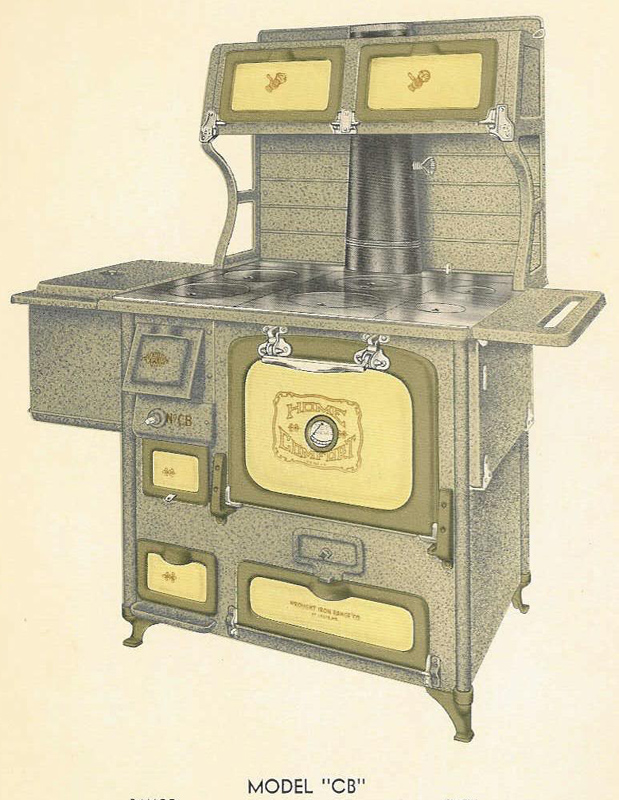|
Moderated by NW Okie! |
Volume 13 , Issue 22011Weekly eZine: (366 subscribers)Subscribe | Unsubscribe Using Desktop... |
Home Comfort Range (1934) - Chimney Construction

Last week we promised you some information from our Home comfort Range cookbook about the Chimney construction and the most common faults in construction and care of chimneys.
Chimney Construction
Until recent years there were very few chimney builders, or even architects, who knew anything about the science of drafts of the requirements of a chimney.
The average brick mason throws up a pile of brick and mortar full of pockets and offsets, and calls it a "chimney." The name is a misnomer. So, in the interest of the afflicted we give below for you guidance such information as our sixty odd years experience now suggests.
The first and foremost purpose of a chimney is to produce a draft that will cause sufficient combustion to carry off the resulting smoke. Many unsatisfactory cooking and heating plants, and much excessive fuel consumption are due to improperly constructed chimney. The chimney furnishes the draft. However, one often hears such expressions as --
"My stove will not draw;"
"It fills up with soot;"
"The fire will not burn;"
"The oven will not bake on the bottom."
Such complaints will never end until the cause is removed -- and the cause, nine times out often, is a poor flue.
If it were possible for the manufacturer to furnish a flue with each stove or range sold, there would be no such thing as a stove or range that did not do its work satisfactorily.
The National Board of Fire Underwriter's Report shows that a larger number of fires are caused by defective chimney construction than anything else.
Most Common Faults in Construction & Care of Chimneys:
1st - The use of unsuitable materials - Clay sewer pipe -- hollow building blocks, or unprotected concrete should never be used.
2nd - The improper laying of brick. Brick should never be laid on edge. Linings should be used in all brick chimneys where the walls are less than 8 inches thick.
3rd - The lack of proper support for chimneys. No chimney should be carried on any timber-construction of the building, and where it rests upon the ground sufficient masonry foundation should be provided to prevent settling.
4th - Building inflammable material into chimney or against it without proper insulation.
5th - Failure to keep flue free of soot and joints in brick work properly pointed. A leaky flue is the most frequent cause of draft troubles, high fuel bills and destructive fires.
Back in the 1930's they would test chimney for leaks by doing the following: First drive out cold air by burning paper. Then throw a wet blanket over top of flue and start smudge fire in range.
The draft in a chimney depends entirely upon the flue. The better the flue, the more satisfactory and efficient will be the operation of your cooking apparatus. The strength or intensity of the draft is dependent mainly upon the size and height of the chimney flue. A chimney may be high enough, yet have an area too small to carry the volume of smoke. On the other hand, the size may be sufficient, but the chimney too low to produce a draft. Either fault -- or a combination of the two -- will result in unsatisfactory service.
A straight, round flue not less than 9 inches in diameter on the inside and built higher than the house or other obstructions will furnish the necessary draft for family stove or range.
The minimum height of a chimney for family stove or range should not be less than 35 feet above the fire pot -- the higher the better. Some authorities contend that any flue under 40 feet in height will produce an erratic draft -- good some days and poor others.
Chimney Connections
Many fires are caused by more than one opening in the flue. This should never be permitted as sparks may enter the flue at one opening and pass out into the house at the other. Not only is there risk of fires from 2 openings, but this is one cause of unsatisfactory draft.
Next week we shall bring you some more information about Home Comfort Range materials.
| View or Add Comments (0 Comments)
| Receive
updates ( subscribers) |
Unsubscribe
| © . Linda Mcgill Wagner - began © 1999 Contact Me | |
